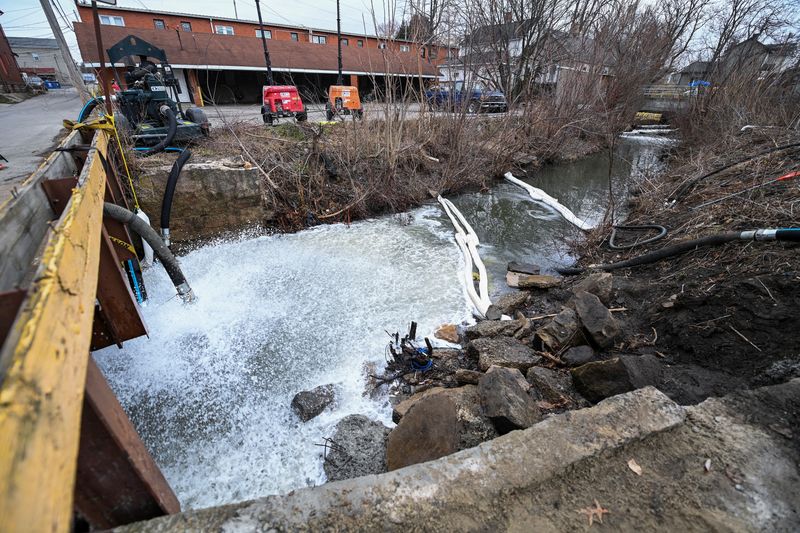By Brad Brooks
(Reuters) - Ahead of U.S. Transportation Secretary Pete Buttigieg's visit on Thursday to the site of a toxic train derailment in Ohio, here is what we know about the scope of the incident:
HOW MUCH TOXIC MATERIAL WAS RELEASED?
Neither the Environmental Protection Agency (EPA) nor Norfolk Southern , the company that operated the train that derailed in the Feb. 3 spill in East Palestine, Ohio, has said how much toxic material was in the train cars.
The EPA has identified the type of rail cars involved and the chemicals they carried. Norfolk Southern did not reply to specific inquiries about how much each car was carrying.
Federal rules specify how much of any toxic chemical can be carried in a particular rail car, and based on experts saying the cars were likely to be full to be cost effective, Reuters calculated that up to 1.1 million pounds of vinyl chloride was likely aboard.
The same figure was cited in a federal class action lawsuit filed in federal court last week by Morgan & Morgan law firm against Norfolk Southern Railway and parent company Norfolk Southern Corp (NYSE:NSC).
Such an amount would be more than twice the amount emitted across the entire United States by companies in 2021, the latest year of available data in the EPA's "toxic release inventory" database.
The EPA said in an email that most of the vinyl chloride was purposefully set afire to avoid a catastrophic explosion while cars burned for days.
Vinyl chloride is a highly flammable, carcinogenic gas used in making plastic products that can cause dizziness, headaches and drowsiness when inhaled in the short term and a rare form of liver cancer after chronic exposure, the EPA has said.
The agency said it did not know how much of other hazardous materials was leaked and did not confirm how much was aboard, but said "response efforts assumed all the contents of the rail cars leaked to ensure the most protective action."
Norfolk Southern declined to comment in response to requests for details on the amounts of chemicals involved. The company CFO said on Wednesday the company will take responsibility for cleaning up after the derailment.
The National Transportation Safety Board plans to release a preliminary report on Thursday on its initial findings into the crash. Former President Donald Trump visited the site on Wednesday.
WHAT ARE THE RISKS TO THE PUBLIC?
The EPA has said repeatedly that its tests of drinking water and air inside homes near the wreck site have not shown any contamination.
But that, experts say, does not answer the question of what exposure residents suffered in the hours immediately after the wreck, before monitoring was in place.
Ila Cote, a toxicologist who worked at the EPA for nearly three decades carrying out disaster risk assessments on public health and is now a private consultant, said the long-term health damage, such as increased likelihood of cancer, from the short-term initial exposure to the toxic chemicals is extremely complicated to determine.
"The data on cancer risk from a single high exposure is not good," Cote said. "But it would certainly be safe to say that if people had been highly exposed to vinyl chloride, they would incur increased risk of cancer."
WHAT ARE OTHER CONCERNS?
Three days after the crash, state and local officials said concerns about a massive explosion as pressure built in rail cars carrying the toxic chemicals forced them to drain five cars of vinyl chloride into a makeshift ditch and purposefully set it ablaze.
That controlled burn created new carcinogenic byproducts known as dioxins, said Murray McBride, a Cornell University emeritus professor with expertise in environmental toxicology.
He said those pollutants were carried away in a giant plume of smoke and likely came back to earth on soot, potentially contaminating several miles of land downwind where it could enter the food supply and upend the agricultural industry in the area.
It is crucial, McBride said, to learn how much of the chemicals may have combusted during the "controlled burn" versus how much seeped into groundwater, where it can persist for decades and remain a deadly risk.

Cote, the former EPA toxicologist, said that such controlled burns are often times the best decision emergency responders can make in such situations.
"I'm generally in favor of these types of controlled burns, If you get these chemicals leaking out, it's hard to deal with them quickly, you can't just scoop them up," Cote said.